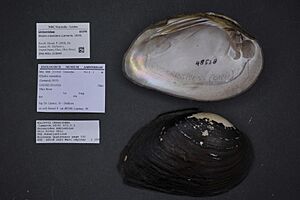Elephant-ear facts for kids
Quick facts for kids Elephant-ear |
|
|---|---|
 |
|
| Conservation status | |
| Scientific classification | |
| Genus: |
Elliptio
|
| Species: |
crassidens
|
| Synonyms | |
|
|
The elephant-ear mussel (scientific name: Elliptio crassidens) is a type of freshwater mussel. It's an animal that lives in water. This bivalve mollusk belongs to the Unionidae family, also known as river mussels.
Contents
What is an Elephant-Ear Mussel?
The elephant-ear mussel has a thick shell. Its shell is shaped like a triangle. It can grow up to six inches (about 15 centimeters) long. The outside of the shell is usually brown or black. Inside, the shell is often a light purple color.
Where Do They Live?
You can usually find these mussels in large rivers. They like to live in mud, sand, or fine gravel at the bottom of the river.
Elephant-ear mussels live in many places. They are found in the midwestern, eastern, and some southern states of the United States. You can also find them in the Canadian provinces of Quebec and Ontario.
How Do Elephant-Ear Mussels Live?
Elephant-ear mussels are filter feeders. This means they eat tiny bits of food from the water. They mostly eat bacteria, protozoans, algae, and plankton.
Breeding and Life Cycle
Elephant-ears usually breed once a year. Their breeding season is short. It can be from April to May or from June to July. Both male and female mussels become ready to breed when they are four to six years old.
The baby mussels, called larvae, stay inside their mother's gills. They stay there for a few weeks to a few months. After this, the tiny mussels attach themselves to the fins or gills of a fish. They live on the fish for several weeks. This is a special stage where they get a ride and grow.
Once they are big enough, the young mussels let go of the fish. They fall to the bottom of the river. There, they dig into the mud or sand. They grow into adult mussels. These mussels usually don't move far from where they land. They might only move a few meters in their whole lives.
How Long Do They Live?
Like other mussels, elephant-ears can live a very long time. They are thought to live from 20 years to as long as 100 years!
Who Eats Elephant-Ears?
Several animals like to eat elephant-ear mussels. Common predators include otters, raccoons, and muskrats. Birds like herons and egrets also eat them. Many different types of fish will also prey on these mussels.
Conservation Status
Even though elephant-ears are found in many places, they are not always common. They are quite rare in the Midwest region of the United States. However, you can find many of them in some parts of the Ohio and White rivers in Illinois and Indiana.
The elephant-ear mussel is listed as endangered in several states. These include Minnesota, Missouri, Wisconsin, Ohio, and Virginia. In Illinois, they are considered threatened. This means their numbers are low and they need protection.


